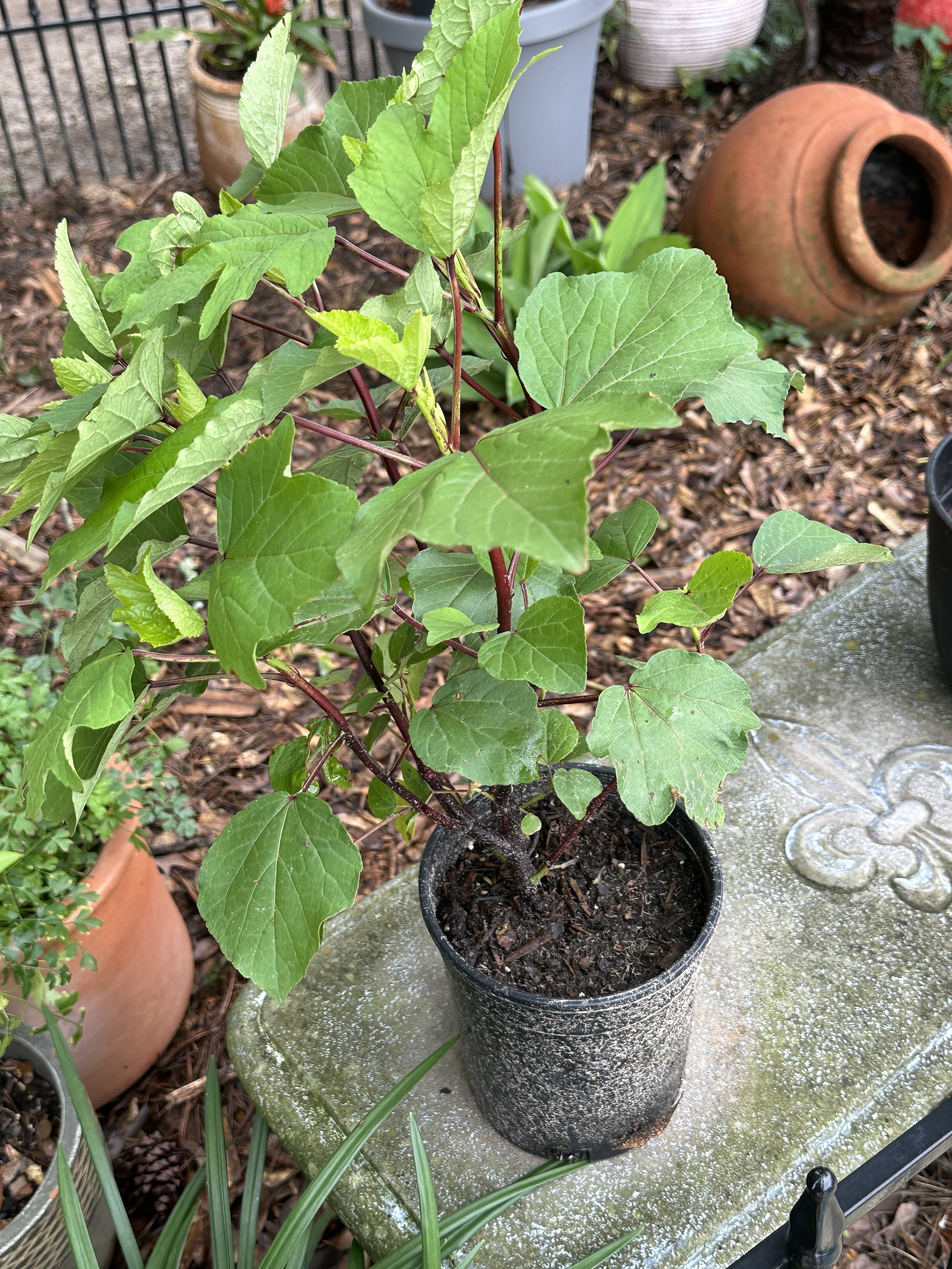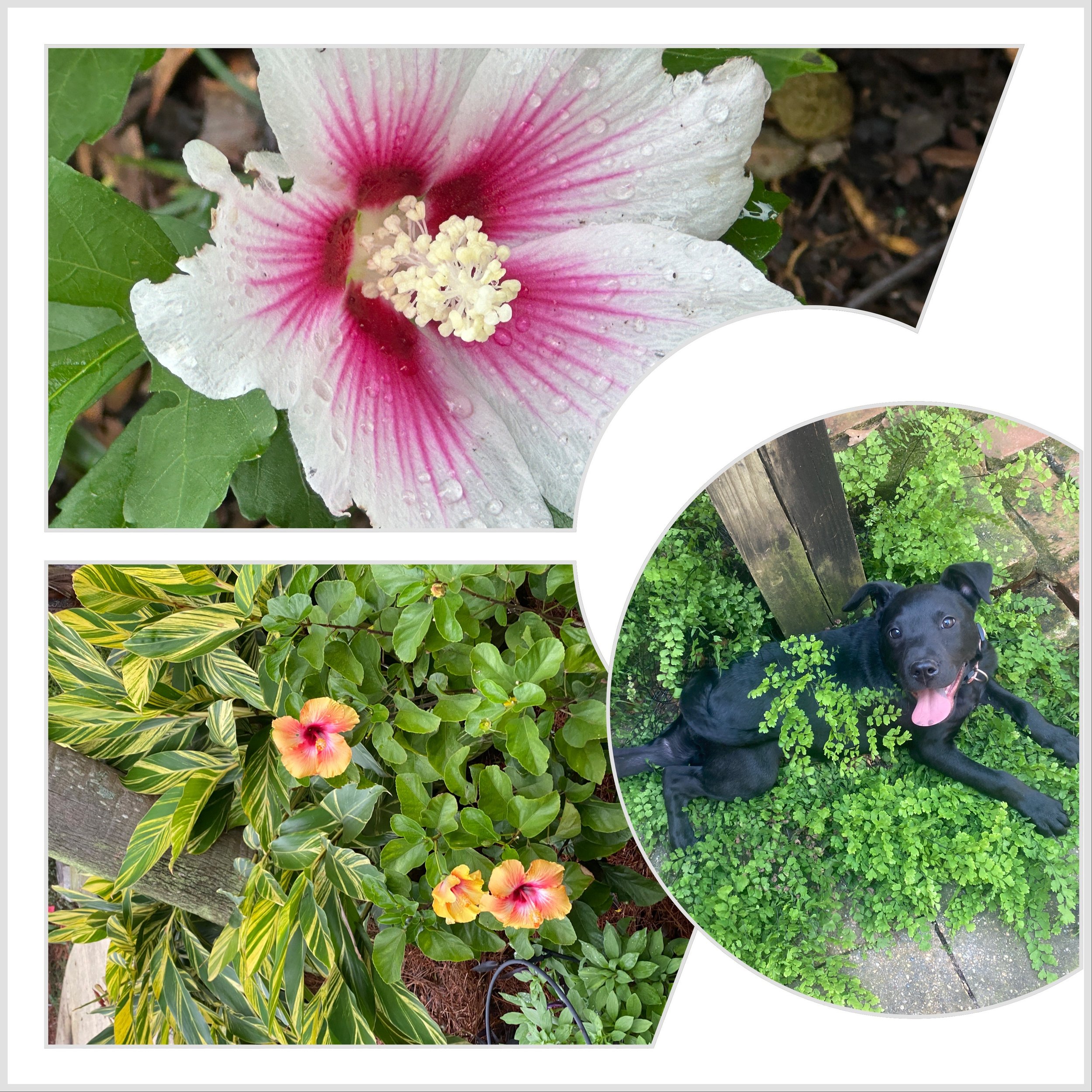Surprisingly, edible plants for you and me, but are they suitable for dogs?
Sisters
Malibu plays peek-a-boo over the gate at Maze while the Bougainvillea behind them is starting to bloom.
Ever wondered what happens when you combine the love for large dogs with a plant addiction?
Temptation strikes at least once a week.
I'm either at the farmers market, the garden center, or the local nursery looking for my next fix. Never mind that I have no idea where I will squeeze my purchases into my backyard, which is overflowing with plants, let alone ensure they get ideal growing conditions. That presents another challenge.
The colorful allure and myriad textures are as compelling to me as they are to my four-legged friends. The endless stream of plants is Santa's sack to them. They're sniffing around, ready to ditch one plant for another (ooh, that one smells new) as the novelty of one plant wears off like they're last year's toys.
To them, the backyard is wine country, so I've fenced off most of the flowerbeds. Sorry, guys, no wine tours here. Taste-testing ended when you licked your dinner bowl to a sheen.
Surprisingly, some of the plants in my backyard are edible, and a few are dog-friendly.
Hostas
Asians have eaten hostas for ages, mostly the early shoots, even though the entire plant is edible. Hostas pack health rewards such as flavonoids and steroids, which may combat cancer, inflammation, and viral infections.
You'll want to avoid slipping Hostas to Fido, who is waiting for scraps under the dining room table.
The phytochemicals in Hostas that benefit you and me can harm your dog's gastrointestinal tract and diminish his body's protein intake and other significant vitamins.
Hostas
Lovely leaves make their debut in spring in front of a Camellia tree.
Dianthus
Asians have long used Dianthus, or pinks, in traditional medicine. The dried flower is a diuretic. Dianthus has been used as a digestive aid and to help lessen inflammation.
The flowers have a spicy, clove-like taste. Microdianthus is one of the more edible accent varieties. The plant is eaten in soups and salads and serves as a pastry garnish. The crystallized petals embellish cakes. It's purported that the French herbal liqueur Chartreuse, aka "Elixir of Life," contains Dianthus as one of its many ingredients.
Dianthus are not pet-friendly. Slip a few dianthus flowers to Fido, and you may be toweling up his mess or rushing him to the emergency vet clinic. Dianthus may also cause him to break out in a rash.
Dianthus
One of many clumps growing in the yard.
Cornflower (aka bachelor button)
Like marigolds and nasturtiums, cornflowers are high in antioxidants and may prevent or amend problems that arise on a cellular level in our body. The list of cornflowers' potential human health benefits is extensive. It's said that the extract can soothe skin irritation, and it may even prevent age-related and steroid-induced muscle loss.
Cornflower is dog-friendly. Most dogs will be just fine if they develop a case of the munchies during play and nibble on one of the tiny, blue flowers, but there are those pups with digestive sensitivities. It's best not to encourage snacking on any plant.
Cornflower or Bachelor’s Button
They were seeded in February in the blueberry bed.
Dandelion
Don't weed it!
Dandelion dates back thousands of years from Eurasia. Settlers brought it to North America, where it was cultivated and became a panacea used to treat many diseases, including cancer.
This tiny flower packs a bunch of vitamins for everyone. Its greens offer 2x the protein as spinach. It provides vitamins A, K, C, and B complex and trace minerals.
More importantly, it's dog-friendly and a vital source of nectar and pollen for pollinators such as bees, which are crucial for crop growth. You can find many alternative health products for pets that contain dandelion root to support the liver, digestive, and cardiovascular systems. Check with your vet before using alternative medicine to treat your pets.
Hibiscus
You may have heard of hibiscus tea and its medicinal value, but most flowers, leaves, and seeds are edible and used to make jams, jellies, sauces, and tea. Egyptians drank hibiscus tea to lower blood pressure.
Hibiscus sabdariffa has a long history of use in folk medicine. Due to its high content of phenolic acids, flavonoids, anthocyanins, and organic acids, hibiscus has antioxidant, anticancer, anti-inflammatory, and antiviral properties. It is also a source of fiber.
Overall, hibiscus is dog-friendly, except for the Rose of Sharon hibiscus native to Asia. According to Hannah Hollinger writing for the WAG website, the Rose of Sharon eaten in large quantities is mildly toxic to dogs.
Hibiscus Sabdariffa aka Roselle,
I received a new hibiscus from the Feliciana Flower Festival and my friends at Lagniappe Flower Farm. I don’t know where to plant it.
Eating plants and Alternative therapy
As you would with any prescription medication or alternative therapy, check with a medical expert before eating or taking supplements containing any of the plants mentioned above. Check with a veterinarian if you think your dog is experiencing a reaction or if you are thinking of offering herbal supplements. I found that many doctors and veterinarians are open to alternative therapies.
In the meantime, happy planting with the pups!
Which one is your favorite flower?
A) Paraplu Pink Ink Rose of Sharon (pictured top)
B) Sunset Hibiscus (pictured bottom)
C) Malibu playing in the ferns
References:
"Cornflower." American Society for the Prevention of Cruelty to Animals, www.aspca.org/pet-care/animal-poison-control/toxic-and-non-toxic-plants/cornflower. Accessed 5 Jun. 2024.
"Carnation." American Society for the Prevention of Cruelty to Animals, www.aspca.org/pet-care/animal-poison-control/toxic-and-non-toxic-plants/carnation. Accessed 5 Jun. 2024.
"Dandelion." Mount Sinai, www.mountsinai.org/health-library/herb/dandelion. Accessed 5 Jun. 2024.
"Hibiscus." American Society for the Prevention of Cruelty to Animals, www.mountsinai.org/health-library/herb/dandelion. Accessed 5 Jun. 2024.
Hollinger, Hannah, and Linda Simon MVB MRCVS. "Rose of Sharon Poisoning in Dogs." WAG!, 10 Nov. 2016, wagwalking.com/condition/rose-of-sharon-poisoning. Accessed 5 Jun. 2024.
"Hosta." Pet Poison Helpline, www.petpoisonhelpline.com/poison/hosta/#:~:text=Hostas%20contain%20saponins%2C%20bitter%20tasting,mild%20signs%20that%20resolve%20rapidly. Accessed 5 Jun. 2024.
Jalalyazdi, Majid et al. “Effect of hibiscus sabdariffa on blood pressure in patients with stage 1 hypertension.” Journal of advanced pharmaceutical technology & research vol. 10,3 (2019): 107-111. doi:10.4103/japtr.JAPTR_402_18
Liu, Qian et al. “Dianthi herba: a comprehensive review of its botany, traditional use, phytochemistry, and pharmacology.” Chinese medicine vol. 17,1 15. 21 Jan. 2022, doi:10.1186/s13020-022-00570-2
Montalvo-González, Efigenia et al. “Physiological Effects and Human Health Benefits of Hibiscus sabdariffa: A Review of Clinical Trials.” Pharmaceuticals (Basel, Switzerland) vol. 15,4 464. 12 Apr. 2022, doi:10.3390/ph15040464
Nguyen, Ngoc Bao et al. “Cornflower Extract and Its Active Components Alleviate Dexamethasone-Induced Muscle Wasting by Targeting Cannabinoid Receptors and Modulating Gut Microbiota.” Nutrients vol. 16,8 1130. 11 Apr. 2024, doi:10.3390/nu16081130
Readal, Maryann . "Dianthus – Herb of the Month – A Plant of Beauty and Meaning." The Herb Society of America Blog, 4 Apr. 2022, herbsocietyblog.wordpress.com/tag/chartreuse-liqueur/. Accessed 5 Jun. 2024.
Tilford, Gregory. "Recognizing Dandelion's Herbal Benefits to Dogs." WholeDog Journal, www.whole-dog-journal.com/care/recognizing-dandelions-herbal-benefits-to-dogs/. Accessed 5 Jun. 2024.
"Why Bees Are Essential to People and Planet." United Nations Environment Programme, 18 May 2022, www.unep.org/news-and-stories/story/why-bees-are-essential-people-and-planet. Accessed 5 Jun. 2024.
Yang, Li, and Jun-Wei He. “Hosta plantaginea (Lam.) Aschers (Yuzan): an overview on its botany, traditional use, phytochemistry, quality control and pharmacology.” RSC advances vol. 9,60 35050-35058. 30 Oct. 2019, doi:10.1039/c9ra06623c





